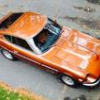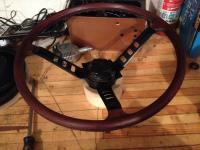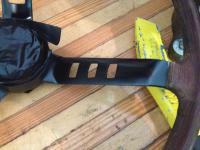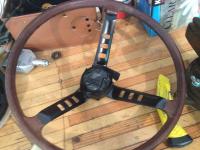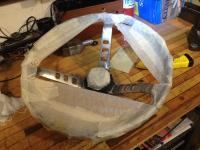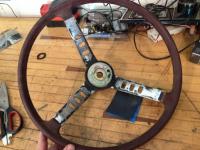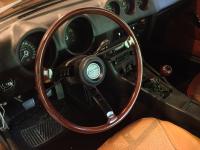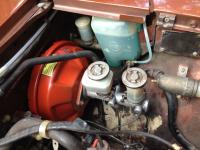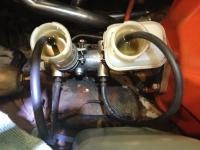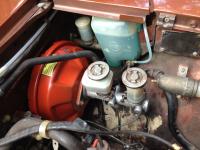-
A better Auxilary Air Regulator
Update: Mine arrived and is installed AND is much better for my car. When it arrived, I took it apart and found it to be a simple mechanism. I adjusted it for maximum air flow when cold and bench tested it with a 12V DC source and it closed completely after about 5 minutes. Installed it in my 1976 280Z and found that it worked much better than the original (which didn't seem to do much at all despite my efforts to adjust it). Now I get a cold idle of about 1200 RMP which is good for my motor in cold weather. After about five minutes it settles down to the speed set by the idle set screw. I am very happy with it. YMMV. These are simple things: Its nice that this version can be disassembled for inspection, cleaning, and adjustment. Dan
- A better Auxilary Air Regulator
-
A better Auxilary Air Regulator
I'm going to give one of these a shot. My AAR has never been right. I installed a ball valve last winter (I just let it warm up and close the valve before I hit the road). When summer came around, I went back to the original AAR and it was OK but, when it started getting cold out this fall, I had to go back to the ball valve. For $29, I'm going to give one of these a try. I'll let you know how it goes.
-
My steering wheel restore detailed.
I think if you sand it smooth (maybe 320 grit sand paper) and get some stain on it, its going to look great. The 240Z wheel I picked up a couple of months ago looked pretty rough before I started but it came out nice. I just did mine last weekend, pretty much following the above process (stain, then I think I had 5 or 6 VERY thin coats of spar urethane applied with a small foam brush, treated between coats with 000 steel wool):
-
Help with yogurt cup test please...
Yeah, that was me. I replaced the BCDD diaphragms with replicas cut from nitrile gloves - I have a laster cutter in my basement . This fixed the leak but I have been too chicken to connect it again. I guess I'm waiting to get everything else sorted out before I try it (I'm still running with my TPS disconnected because one of the switches or wiring seems to be bad). If anyone on this forum has the same problem, I'd be happy to send them nitrile replacements. I have no idea how well they will stand up under actual use. My old post about BCDD leak and rebuild is here
-
Help with yogurt cup test please...
If all else seems right, check your BCDD - this is where I found a leak on my 1976 Z when I resorted to the yogurt cup test. I could hear it though. Blow hard, find someone with good ears. The condition of my BCDD diaphragms were so bad that I'm surprised that I don't hear about the same problem more often here. It sounds more like you have a vacuum leak but some other diagnostics worth trying (to help eliminate these systems as being part of your problem): Try running with the TPS disconnected and observe any differences in performance/gas mileage. Also maybe try disconnecting the CSV after you start. I would add the temp sensor pot as well (even though you have a newish ECM - who knows exactly how these things are reconditioned).
-
Garage Gremlin has struck again!
This is the coil I run on my 1976 280Z with 1979 280ZX distributor/ignition module (appropriately rewired - no ballast). $15. Runs great: https://www.rockauto.com/catalog/moreinfo.php?pk=4589205&cc=1209293 I had a crazy tach with the old distributor/ignition module with occasional cut outs (also a ZX flavored). New distributor/ignition module fixed that problem for me ($90 + core): Product Detail
-
Broken Radiator Drain Petcock
One of the above or an easy out would probably work too. Or you could cut a slot for a flat headed screw driver with a tiny dremel cut-off wheel.
-
Fuel Pressure Guage
While working on the Z over the weekend I took a movie of my fuel pressure gauge for fun and enjoyment (and as a record of what its behavior is when the motor is running well). Though you all might be interested:
-
Brake Booster Leak - Early Warning Signs in EFI - and a Cautionary Tale
I recently posted in my reliability update the my brake booster was leaking. Once it gets bad, its easy to diagnose: A sucking sound in the cabin when brakes are applied along with hard braking and engine surge during braking. Long story short: All of this goes away once the brake booster is replaced and everything is properly re-attached. Early Warning Signs What I didn't realize is that my Z was telling me for a few weeks that the brake booster was going bad. It did this with an occasional engine surge at idle (it would only go down to maybe 1500 rpm's at a stop light). When this happened though, I would give the throttle a quick kick and it would get back to normal. Because of this behavior I attributed the problem to my recently adjusted dashpot (prior to adjustment it was out of the picture) or a sticky linkage. I figured it was getting sticky and it was on my list of things to look at some day. During this period when the brake booster was going bad, there were no other braking problems. Braking was strong and there was not cabin noise while braking. Fast forward to about 10 days ago and I get the classic brake booster issues: Hard braking, sucking sound in the cabin during braking, engine surge during braking. So I replace the brake booster (see cautionary tale below) and the brakes work really nicely, classic symptoms are gone. But, now, also gone is my stop light slight engine surge. No more need to kick the throttle (yay!). A Cautionary Tale Some of you may have caught this on the Help Me board. I change the brake booster last week. Its really an easy job to do (maybe 2 hours, if that - you do have to be a little bit of a contortionist to get to the bolts under the dash). Don't make the mistake I did: It turns out that the replacement booster was somewhat larger than the old one (and I can feel the difference in braking). When I went to hook up the master cylinder to the hard lines I was careless in alignment (I think maybe that the larger booster slightly changes the alignment of the hard lines to the master cylinder slightly) and I could not get the hard lines connected. In the end, I wasted more than a few hours recovering from this and I almost had to replace one of the hard lines but managed to dremel out the burr that I had created while thrashing with the lines. So, be sure to always get those brake lines nicely square before attempting to connect them. If you search the Help Me forum for finger blisters, you can find the whole story. Here it is all done though (I decided to paint the new booster, I think it looks good):
-
1976 280Z Reliability Update
Hampton Beach Casino is my favorite place to see a concert. The Gogo's would be great there. I will check that seal again. Thanks. I have a break booster story that I will post in a separate thread to make it easier to find.
-
Reattaching brake lines to master cylinder: Finger Blisters yet Still not done!
I tightened it one last time (the fitting was a little chewed up so tightening was not easy) and its all good. No leaks, brakes work great. Put 60 or so miles on it over the weekend. ALL DONE! We got the timing belt on the 99 Accord done over the weekend as well (its own adventure). Thanks again for all the help.
-
Reattaching brake lines to master cylinder: Finger Blisters yet Still not done!
Here's the news: Last night I went to the local Orielly's and bought a couple of brake lines with fittings, a couple of separate fittings, and a flaring tool. I also picked up some nitrile gloves that are a perfect fit - so much better than the baggy ones I had... Ready to go. So today I hit the garage, cleaned up everything, cleared the bench, put the pile of tools away. Put on my old-man glasses. Got out the dremel out and found a tiny tapered grinding bit. Went to put on some JT but accidentally put on Aerosmith instead. 30 seconds with the dremel, dabbed a tiny bit of anti-cease, tried it, and it went right in (for the record, Walking In The Sand was playing)!!! 15 minutes later it was all back together and bled and all working nicely. That's the good news. The breaks work great and the new booster fixed the original problem very nicely (hard braking along cabin whistle when breaking accompanied by engine surge). The bad news is that the fitting might have a tiny leak because, after cleaning everything up and taking it for a test ride, I noticed a small puddle on the frame below but it may be that I overfilled it a little bit. We'll see. If it is a leak, its very slow but I may have to replace that line yet. I'll keep a close eye on it and tackle it next weekend if I need to (change the line). In the end, the problem was a tiny burr that prevented the fitting from starting. The burr was probably caused by not having the lines nice and square when I first went to reattach them then I thrashed for a bit, probably causing more damage. Had to come here for a talking to. Thanks for all the help. I'll follow up next weekend with, hopefully, the final conclusion.
-
Reattaching brake lines to master cylinder: Finger Blisters yet Still not done!
Spent 15 minutes last night. No joy. No JT either, maybe that is my problem. Blisters are healed though. Will try one more time tonight but I don't think its going to go. I might see if I can clean up the start of the thread with a dremel. The line still goes on the 10x1 nut OK but it just doesn't want to start in the master cylinder fitting, even with the master cylinder loose. I have considered removing the fitting from the master cylinder (I know there is stuff that I need to catch) and starting the fitting that way, then carefully putting it all back. Tonight or tomorrow morning Buying: Double flare tool kit (I think there is room), Two sections of brake line with connectors. JT Greatest Hits. Beer. I'm doing a timing belt on a 99 Accord this weekend too (after a failed attempt last weekend - another story but at least the Accord can still be driven - it has been a bad week).
-
Reattaching brake lines to master cylinder: Finger Blisters yet Still not done!
I picked up a 10x1 nut and bolt at lunch and tried them on the line/master. The bolt went into the master no problem but the it was hell to get the nut on the line. Add vice grips and a long socket and the nut cleaned up the connector pretty nicely. Now the nut goes on/off the line pretty easily but a quick try at connecting the line failed. I had to get back to work so was not persistent. Besides, persistence had failed me in this case. It seems like I need to control my persistence.
Important Information
By using this site, you agree to our Privacy Policy and Guidelines. We have placed cookies on your device to help make this website better. You can adjust your cookie settings, otherwise we'll assume you're okay to continue.




